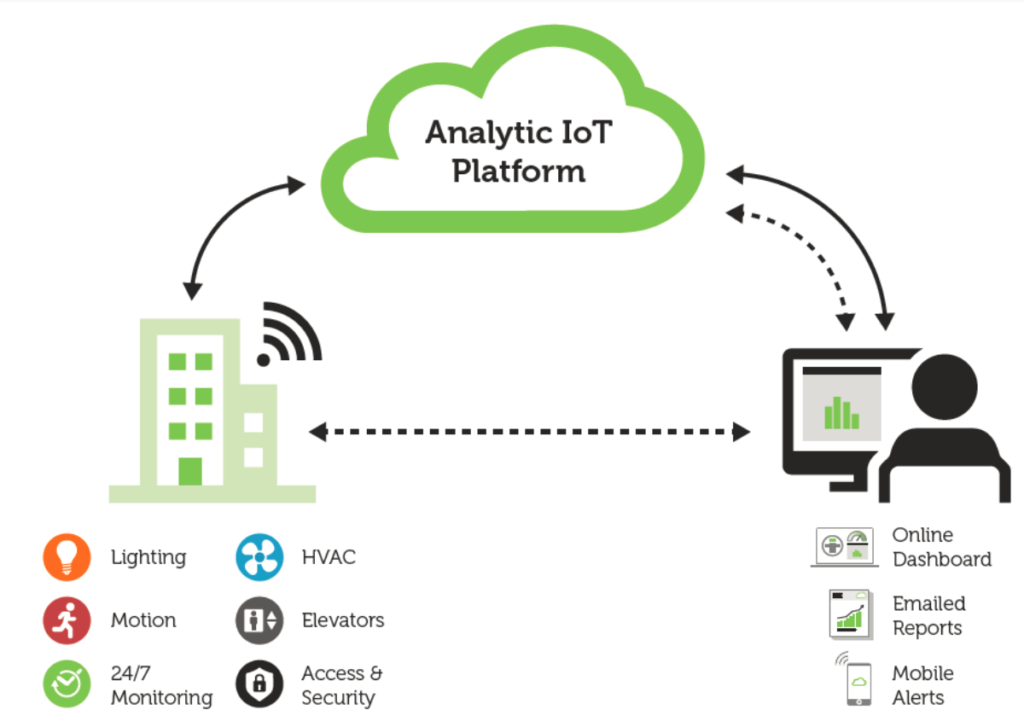Office buildings, hospitals, and other large scale commercial buildings account for about 30-40% of the total energy consumed worldwide, with the heating, ventilation, and air conditioning (HVAC) systems in these buildings accounting for almost 50% of each building’s total power consumption.
Achieving efficiency in HVAC operation is one of the tasks long sought after by building managers and operators.
Several parameters may affect an HVAC power consumption efficiency including (but not limited to): the design of the HVAC system itself and its different components (heating coils, fans, valves, etc.) that cannot be modelled as separate systems as their dynamics are highly coupled.
>See also: How smart buildings can use big data to shape the future of work
Other parameters include building design and characteristics, the tuning of the control loops, equipment faults and degradation, the influence of the weather condition change, the desired scheduling, and the impact of human behaviour on the dynamics of the HVAC operation.
Hence, it is challenging to determine a control law to achieve efficiency and sustainability even with advanced control methods. As a result, the business challenge in terms of managing energy costs and associated greenhouse gas emissions is substantial.
Advancements in big data analytics have recently allowed building managers to improve their equipment efficiency to reduce energy costs while maintaining occupant comfort.
However, the key to optimizing energy performance across a portfolio is using the information about what’s happening in real time to predict the future and taking swift actions to eliminate any possible inefficiencies.
>See also: Privacy vs personalisation – building trust in a digital world
In this direction, the connection of the Internet of Things (IoT) and the concept of building energy optimization emerged in the recent years as one of the most important developments in the long evolution of energy management.
The IoT in its simplest definition is all about allowing physical devices, vehicles, buildings, and other items embedded with electronics, software, sensors, and actuators to communicate with each other over the internet in real time to enable these objects to collect and exchange data.
Building systems, in reality, became arguably the first IoT systems over a decade ago when control networking companies first enabled the components of building management systems to become IP hosts with the addition of a single IP router.
Nowadays, more affordable technologies and advancements in IoT are being used to help create operational efficiencies, reducing energy consumption, improving occupant experiences, achieving sustainability goals, and effectively optimising financial performance.
Property executives and facility managers are increasingly considering the data they can collect from buildings, and the analysis they can complete, to uncover patterns and inform decision-making—a process which is often covered by the term “data analytics.”
>See also: The transformation of architecture in the age of smart cities
As the volume of the data generated, transmitted, and received gets so large and complex that it becomes difficult to process using a local data processing application, the term “big data” becomes appropriate in this process.
Advances in platforms using big data analytics, cloud-based intelligent software solutions running as software-as-service (SaaS), and closed-loop control have already demonstrated reductions in HVAC energy consumption by 10-25% during normal operation.
Given the significant achievements claimed in the industry in terms of system efficiency, occupanct comfort, and improved financial returns, it is important to gain a better understanding of the technical underpinnings for those eager to adopt this technology.
Types of data analytics
Using data analytics to turn large volumes of complex data into actionable insights can help us improve engineering design and decision-making processes.
>See also: 10 predictions for the Internet of Things and big data in 2017
However, developing effective analytics and integrating them into business systems can be challenging. To move forward, it is important to identify the different types of data analytics, which include:
Descriptive Analytics: This involves collecting data to help inform us about what has happened.
The projection of descriptive analytics in buildings could include for example collecting sensors data that tell us the fan speed has gone low, zone temperature has gone high, or overall power consumption has increased, etc.
Diagnostic Analytics: These analytics will inform us about why a certain problem happened, for example the fan speed changed due to a building operation schedule change.
>See also: 5 key principles for building an Internet of Things business
Predictive Analytics: This is used to inform us about what will happen, for example, a predicted increase in the entire building’s power consumption, i.e. a demand risk.
Prescriptive Analytics: These further inform us about what should happen and are often involved in finding the best course of action for a given situation.
Analytics removes many of the complexities that are built into buildings. A well-implemented analytics tool for buildings will continually monitor all aspects of the system in near real time: the behaviour of mechanical systems, the control strategies, the effectiveness of any integration, the performance of the user-directed actions, the quality of the environment for occupants, and impact to critical business functions.
>See also: A guide to proximity cards for physical access
A well-implemented analytics solution will do all of that and more in addition to flagging issues for possible human action.
However, the most important step when deciding to deploy a data analytics solution is to identify the process that will be used to act on the information. No matter how good the analytics solution, executing the findings is what drives results.
Data analytics derives actions
The key actions to be performed based on building analytics include running automatic detection of faults/anomalies, fault diagnostic tests, and performance optimization.
The status quo in the industry is the use of descriptive and diagnostic analytics. Most operational, equipment and control logic-related anomaly detection is carried out either manually, or through static rule-based analysis and visualization of data/diagnostics in a web portal/dashboard.
These manual and automatic rule-based systems and dashboards can flag when a problem has already happened and alarms have been generated.
However, they both suffer from obvious defects in that they help building owners and managers understand how a building is operating, but depending on the design, it may not help in understanding “why” a certain issue took a place.
>See also: The UK Government’s Transformation Strategy
Building management has a real need for predictive analytics—to identify issues before equipment fails, pinpoint the root cause of failure, and schedule maintenance as soon as it’s needed.
Nowadays, HVAC optimization systems are moving toward the utilisation of advanced machine learning algorithms (some sort of artificial intelligence and statistical learning based algorithms, e.g., neural networks and support vector machines etc.) to help isolate issues in an HVAC system, correlate these between a number of data streams/variables and suggest possible equipment tuning, and for maintenance and upgrade tasks.
Machine learning algorithms can not only process building HVAC-related energy consumption patterns, but can also incorporate information about outside weather information, building thermal mass characteristics, max/peak demand, energy cost/tariff, and occupancy/comfort patterns and combine these with the building information at the global and at the zone level to predict and optimize energy and comfort.
The interaction between the different sources of information can obviously be fairly complex for a human to comprehend, but more easily handled by such algorithms.
There are efficiency gains to be made if key factors that influence energy consumption can be identified. Unfortunately, rule-based systems by themselves may not be able to capture such interactions easily.

How an IoT-enabled analytics platform works with buildings
Machine learning algorithms, being more advanced artificial intelligence components than the rule-based systems, use computational methods to “learn” information directly from the different sources of data and model their relationship, without relying on a predetermined equation as a model, and to build their own data-driven models that predict future outcomes based on historical data.
>See also: Smart buildings the “killer app” for Smart Grid, says IDC
For example, statistical learning, simulation and predictive modelling can be applied to determine how many chillers need to be turned on, based on forecast occupancy levels and outside weather conditions.
The resulting algorithms can reliably collect, store, and transfer commands/data to the building management systems to make sure that the selected/optimized parameters follow the target settings (for example to make sure the zone temperature follows the zone target temperature).
Diagnostic analytics can then work in parallel with these systems to report if any of the written parameters to the BMS system is not being followed.
The latest advancements in machine learning algorithms gave us what’s known as Deep Neural Networks (DNNs), one of the most capable AI tools for solving very complex problems.
DNNs consume often very raw input data from sensors and processes this data through many layers of nonlinear transformations of the input data in order to calculate a target output.
By considering analogy between DNN and the system dynamics of an HVAC problem, that typically shows highly nonlinear properties and varies widely at different operating points, it seems natural to adopt the application of deep neural networks into HVAC efficiency optimisation, and this will certainly be very exciting to watch.
>See also: Building efficiency
Aggregated data and powerful analytics that add “intelligence” to existing building infrastructure have the potential to transform the way in which building operators manage energy across IoT-enabled buildings.
The future directions in building energy optimisation is expected to utilize the latest advancements in machine learning and optimisation algorithms to model the underlying relation between the different sources of data and the buildings power consumption and to continuously evaluate building systems’ performance to detect/diagnose faults once captured.
Building engineers can be empowered to take a more targeted, data-driven approach to their work while intelligent data analytics improve their productivity helping firms achieve carbon reduction targets and maintain comfort with relatively low capital investments.
After all, the value of these buildings can only be maintained if they are operated cost-effectively and IoT, data analytics, and artificial intelligence are paving the road to achieve that.
Sourced by Rami Khushaba, Ph.D., Senior Data Scientist, BuildingIQ
The UK’s largest conference for tech leadership, Tech Leaders Summit, returns on 14 September with 40+ top execs signed up to speak about the challenges and opportunities surrounding the most disruptive innovations facing the enterprise today. Secure your place at this prestigious summit by registering here







